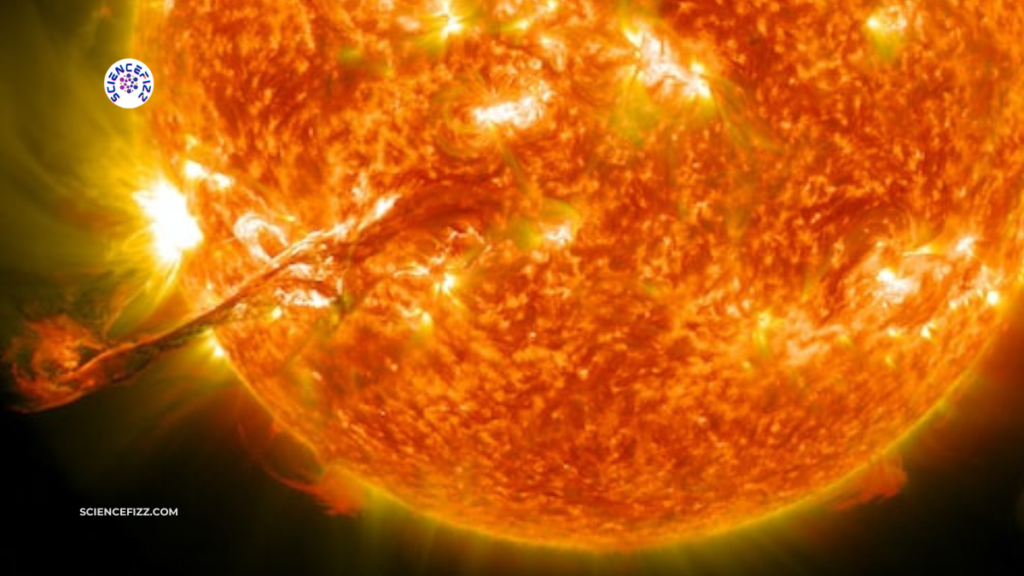The NOAA & SWPC issued the warning for the upcoming strong Solar Storm which is set to hit the Earth and may generate geomagnetic storms on our planet.
The National Oceanic and Atmospheric Administration (NOAA) has issued a warning about an upcoming M-class solar flare that could impact Earth.
As we are all aware, our Sun tends to produce solar flares that are far bigger than our planet. They have the potential for causing a significant amount of impact through geomagnetic storms.
Researchers have successfully replicated these solar flares in a laboratory to better comprehend them. There is a 40% chance of an M-class solar flare occurring today, according to NOAA forecasters.
The Origin of the Impending Solar Storm
The sunspot AR3280, which is growing rapidly, is most likely the source of the solar flare that will likely hit Earth. It is susceptible to M-class solar flares and possesses a fluctuating beta-gamma magnetic field.
Solar flares are categorized into A, B, C, M, and X intensity classifications based on their strength. The strongest solar flares are X-class flares, followed by M-class flares.
Read Also: ISRO Aditya-L1: India’s First Solar Mission To Explore Sun-Earth Connection
Active Regions on the Sun
Solar flares typically occur in active regions of the Sun, which tend to be defined by sunspot groups and powerful magnetic fields.
These magnetic fields can become unstable as they undergo changes and release energy as electromagnetic radiation, which appears as solar flares.
Impact of Solar Flares on Earth
According to the website SpaceWeather, the sunspot’s nearly straight face of Earth is really concerning everyone. Solar flares can be efficiently blocked by the magnetosphere of Earth, although some charged particles can pass through it.
These high-energy particles have the potential to generate beautiful auroras or Northern Lights, which are magnetic disturbances known as geomagnetic storms or substorms.
Solar particles can disrupt radio signals and the electrical grid when they strike Earth because they have an effect on the planet’s magnetic field.
These effects may cause power outages and radio blackouts that last anywhere between a few hours and several days. However, power grid failures are uncommon these days as they only occur during significantly higher solar flares.
Tech Behind Solar Flare Predictions
Solar Storm and the Sun’s activity are observed by NOAA using its DSCOVR satellite, which went into operation in 2016.
The Space Weather Prediction Center is used to process the data that was recovered from the satellite before the final analysis is created.
The satellite monitors a number of parameters related to the Sun and its atmospheres, including temperature, speed, density, degree of direction, and frequency of solar particles.
Conclusion: Should You Worry About This Solar Storm?
Solar storms are constantly being emitted by the Sun, and some of them are powerful.
The majority of these solar flares are blocked from Earth by the magnetosphere, but they can still harm the planet by causing geomagnetic storms.
The good thing is that NOAA can forecast solar flares and their severity because the agency keeps an eye on the Sun’s activity.
The impacts of solar flares on our planet can be mitigated with the knowledge of these projections.
FAQs Related To Solar Flare Storm
-
What is a solar flare?
A solar flare is an intense burst of radiation that originates from the Sun’s surface which generates a sudden increase in brightness of the Sun.
-
How do solar flares impact Earth?
Solar flares impact the Earth by generating geomagnetic storms that can lead to power grid failures and radio blackouts.
-
Can solar flares be predicted?
Yes, solar flares can be predicted using advanced satellite technology. For example, the DSCOVR satellite is used to predict solar flares.
-
What is an M-class solar flare?
An M-class solar flare is the second most powerful solar flare. The X-class solar flare is the most dangerous solar flare.
-
How does NOAA predict solar flares?
NOAA predicts solar flares by monitoring solar activities using its DSCOVR satellite.
The satellite tracks different activities of the Sun including its atmosphere – temperature, speed, density, degree of orientation, and solar particle frequency.
